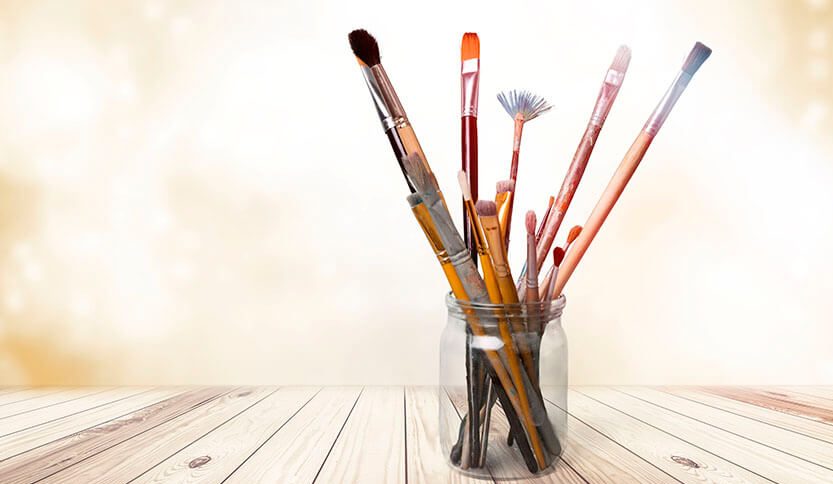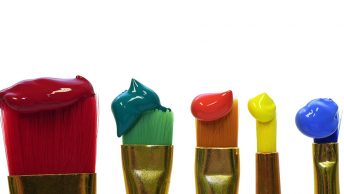Have you ever wondered how to clean your acrylic paint brushes? Is it a constant problem when you have finished your masterpiece that you are going to have to battle with acrylic brush cleaning?
Well look no further, as artists we have experienced the same frustration, we have done the research and have the answers for you. Let’s get into it.
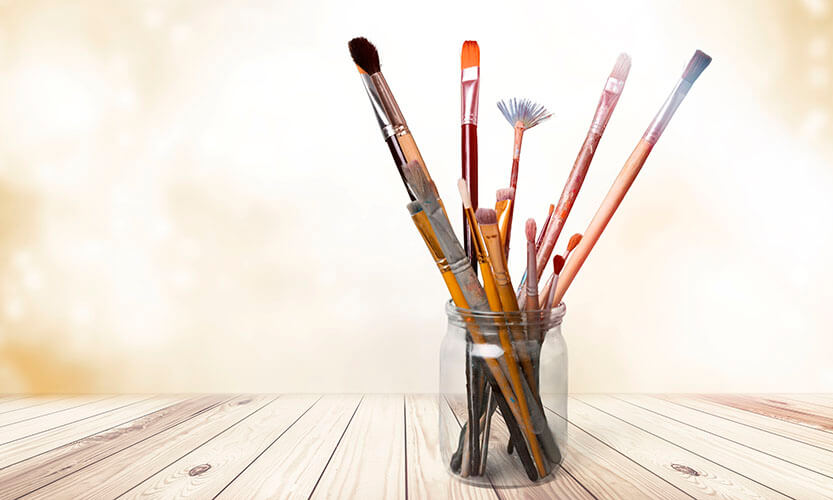
Don’t Let the Paint Dry During Painting Sessions
The fact that acrylic paints dry quickly and are not water soluble when dry, is the reason that they are so great to work with for artists, but that is also the reason acrylic paints are so difficult to clean up afterwards.
So, the over-riding trick to being able to clean your acrylic brushes is to not let the paint dry.
Keep the brushes that you are using wet in between use, if you don’t the paint will dry and cause you more difficulty to clean and also potentially harden and end up damaging your brush.
Do not leave them to soak in a water for the duration of your painting session either as this too can ruin them, just make sure the bristles are kept damp so no residual acrylic paint can dry.
To the same merit if you spill any acrylic paint on a surface, get a soapy wet cloth and clean the paint up straight away, it will give you no problems while it is wet.
- How to clean acrylic paint brushes while painting and how to clean acrylic paint brushes between colours?
If swapping paint colours to use with the same brush, ensure to rinse the paint brush thoroughly before changing colour. Use a paper towel to wipe any excess paint away, rinse until water runs clear, then dry with a clean towel.
It is also a good idea to clean the palette to ensure no residual paint gets on your brushes.
It is very important to make sure there is none of the original colour left in the brush so paint doesn’t build up un-noticed in between the bristles. Should your paint dry don’t worry there is acrylic paint brush cleaner that we will look at a little later on.
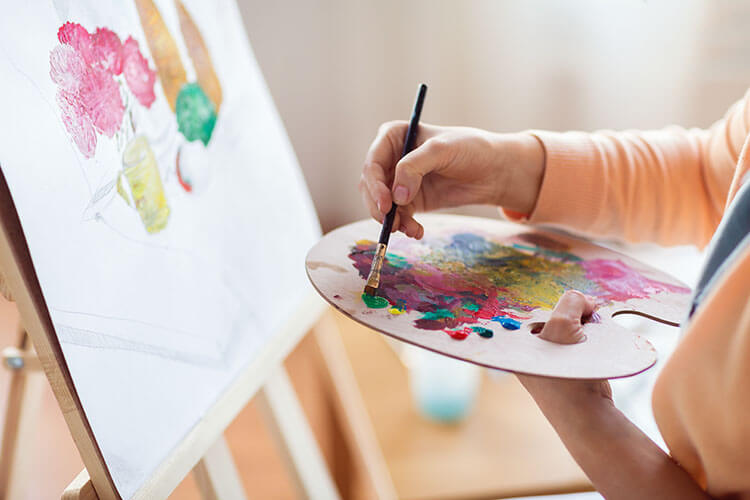
Waste No Time in Cleaning Your Brushes as Soon as You Have Finished Painting
So, you have finished painting and know it is important to clean your paint brushes immediately so let’s discuss how to clean acrylic paint brushes?
- The best way to clean acrylic paint off your brushes is to use a bowl of warm soapy water (gentle washing up liquid or mild hand soap is fine) and rub the brush in circles in your hand, working up a lather.
- It is important to massage between the bristles particularly at the area close to the ferrule.
- Cleaning your paint brushes in the sink as opposed to a designated bowl will also be okay, providing you clean the sink too after your brushes, cleaning up acrylic paint from the metal sink can prove challenging if left to dry.
- There is no need to be too heavy handed, a gentle approach is best as pushing down too hard on the brush can cause bristles to come loose.
- Then rinse under the tap to wash away any soap and remaining paint.
- A quick trick is to take your damp brush and wipe it on plain white paper, this will show up any paint left on the brush on to the paper. Rinse again afterwards.
- Squeeze the tip of any excess water and reshape the brush using your fingers.
- Leave the brush horizontal to air dry, careful that the bristles aren’t leaning on anything that will cause them to dry at an odd angle.
What About Different Types of Brushes?
Whether using natural or synthetic paint brushes cleaning acrylic paint off them requires the same care, attention and speed.
You may find when using natural brushes for acrylic paints that the paint sticks to the bristles more so than it does with synthetic fibres.
All this means it will take a little longer to clean them and it is more imperative that you follow the tip of not allowing the paint time to dry.
So, keep all brushes damp when in use and clean them using the explained method immediately when you are finished with them.
This will prolong the life of your paint brushes.
As artists our tools are very important but they can be expensive, keeping them in the best condition means they can last a long time and they won’t need replacing regularly.
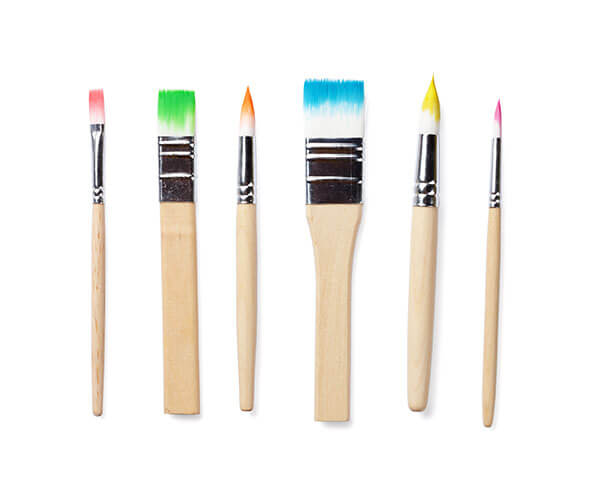
What to Do if the Acrylic Paint Does Dry? How Do You Remove It From Your Paint Brushes Then?
It is not impossible to remove dry paint from your brushes, it just requires some extra care and attention.
- Take some rubbing alcohol and pour it in a jar, ensure you are in a well-ventilated room as the fumes can be very strong. Leave your paint brushes to soak for 5 minutes in the jar.
- Remove from the jar and wearing gloves you will be able to pick the paint out from the bristles.
- Alternatively, take a nail brush and lay the paint brush flat, brush the paint out in gentle strokes from the ferrule to the tip.
- Rubbing alcohol is fine for natural brushes but it will quickly ruin synthetic brushes.
- So, using a brush restoring solution from a reputable brand such as Windsor and Newton would be better suited for synthetic paint brushes.
- Either way, ensure to rinse properly after removing all the paint, and then follow the steps mentioned earlier for drying and re-setting the shape.
Final Tips
- Regularly condition your acrylic paint brushes.
After cleaning use a brush conditioner available at all reputable art stores and rub a little on the brush, working up a lather, before rinsing. A regular gentle hair conditioner will also work for this.
Conditioning your brushes will keep your bristles soft and strong, and help them hold their shape.
- Store your paint brushes once dry either flat, avoiding any pressure on the tips. Or vertically in a pot with the brush tips facing upwards.
- How to clean acrylic paint palette? Avoid, using a wooden palette for acrylic paints, as wood is porous it absorbs the paint as you work and it makes it difficult to clean.
Instead opt for a plastic palette as when dry the paint becomes like rubber and will quite easily peel away. Alternatively throwaway paper palettes have become popular, but they are not the most environmentally friendly option.
Conclusion
Hopefully you have read this article and realised that acrylic paint isn’t as difficult to clean up as you first thought.
While painting, keep your brushes damp, waste no time in cleaning them up after, and should the paint dry, don’t panic, use either rubbing alcohol or a brush restoring solution to remove the acrylic paint from your paint brushes.
Lastly to pro-long the life of your brushes, use a conditioner and your brushes will serve you many years or creative painting.

